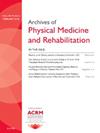利用iTBS和瑜伽对mTBI和慢性疼痛的跨学科合作研究
IF 3.6
2区 医学
Q1 REHABILITATION
Archives of physical medicine and rehabilitation
Pub Date : 2025-05-01
DOI:10.1016/j.apmr.2025.03.017
引用次数: 0
摘要
轻度外伤性脑损伤(mTBI)合并慢性疼痛引起重大的健康挑战,需要创造性的治疗策略。一个由神经心理学家、瑜伽教练、健康服务研究人员和实施科学家以及物理、职业和语言治疗师组成的跨学科研究小组开发并测试了一种新的非药物治疗慢性疼痛的选择。目的:本研究旨在探讨间歇性θ波爆发刺激(iTBS;(一种经颅磁刺激)对神经回路产生累加效应,瑜伽对mTBI和慢性肌肉骨骼疼痛退伍军人的生活质量(QoL)、功能和疼痛有影响。在当前的子分析中,我们专注于获得对生活质量结果的更深入的了解。方法:采用开放标签试验设计,10名退伍军人在参加tbi特异性瑜伽项目LoveYourBrain yoga之前接受iTBS治疗。采用Farmer三角法比较定性和定量结果。结果测量包括自我报告的症状量表和参与后半结构化定性访谈。结果:参与者报告说,iTBS使他们的大脑为瑜伽做好了准备,并增加了他们在参与后自我管理疼痛的信心。TBI生活质量量表证实了这一点(t(9)=2.03;P =0.02),与参与者的自我报告一致。然而,TBI生活质量综合评分并不一致(t(9)=-5.17, p=0.65),也没有反映出iTBS + 瑜伽对参与者自我健康管理和非药物疼痛管理的信心增加的作用。结论:我们的研究结果表明,将先进的神经学技术与瑜伽等补充健康疗法相结合,为慢性疼痛的非药物康复提供了一种创造性的跨学科方法。本文章由计算机程序翻译,如有差异,请以英文原文为准。
A Transdisciplinary Collaborative Study of mTBI and Chronic Pain Using iTBS and Yoga
Mild traumatic brain injury (mTBI) with comorbid chronic pain causes significant health challenges, necessitating creative treatment strategies. A transdisciplinary study team comprised of neuropsychologists, yoga instructors, health services researchers and implementation scientists, and physical, occupational, and speech therapists developed and tested a novel nonpharmacological treatment option for chronic pain. Objective: The parent pilot study (clincaltrial.gov #NCT04517604) explored the effects of intermittent theta burst stimulation (iTBS; a type of transcranial magnetic stimulation) to have an additive effect on the neural circuits with yoga on Quality of Life (QoL), function, and pain among Veterans with mTBI and chronic musculoskeletal pain. In the present sub-analysis, we focused on gaining a deeper insight into the QoL results. Methods: Utilizing an open-label trial design, 10 Veterans received iTBS before participating in a TBI-specific yoga program, LoveYourBrain Yoga. The Farmer triangulation method was used to compare qualitative and quantitative outcomes. Outcome measures included self-reported symptom scales and post-participation semi-structured qualitative interviews. Results: Participants reported that iTBS prepared their brains for yoga and increased their confidence in self-management of pain post-participation. This was confirmed with TBI QoL subscales (t(9)=2.03; p=0.02) and as reported with the participant's self-report. However, TBI QoL composite scores did not agree (t(9)=-5.17, p=0.65) nor capture the role iTBS + Yoga had on participants' increased confidence in self-management of health and non-pharmacological pain management. Conclusion: Our results suggest integrating advanced neurological technologies with complementary health therapies such as yoga presents a creative, transdisciplinary approach to nonpharmacologic rehabilitation for chronic pain.
求助全文
通过发布文献求助,成功后即可免费获取论文全文。
去求助
来源期刊
CiteScore
6.20
自引率
4.70%
发文量
495
审稿时长
38 days
期刊介绍:
The Archives of Physical Medicine and Rehabilitation publishes original, peer-reviewed research and clinical reports on important trends and developments in physical medicine and rehabilitation and related fields. This international journal brings researchers and clinicians authoritative information on the therapeutic utilization of physical, behavioral and pharmaceutical agents in providing comprehensive care for individuals with chronic illness and disabilities.
Archives began publication in 1920, publishes monthly, and is the official journal of the American Congress of Rehabilitation Medicine. Its papers are cited more often than any other rehabilitation journal.

 求助内容:
求助内容: 应助结果提醒方式:
应助结果提醒方式:


